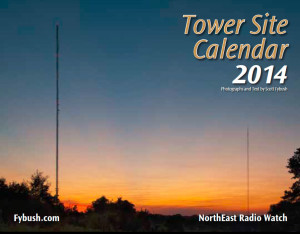NorthEast Radio Watch 12/8/2025: Cichon’s Back in Buffalo
In this week’s issue… Veteran newsman returns - Remembering NY's Leitner, RI's Jones - CT AM saved - Maine AM moves - "Indie" adds suburban signals
By SCOTT FYBUSH
We’re kicking off a big year in the history of NERW: the spring of 2014 will mark the twentieth anniversary of this column, and we’re planning a big celebration for all our loyal readers.
But before we get to the big two-oh, it’s time for our annual review of the year gone by. As we did last year, we’re bringing you Year in Review 2013 in a series of daily installments through New Year’s Eve, which we’ll collect on one page for archival purposes at the start of 2014.
Click here for Part 1: The Year in Station Sales
Click here for Part 2: Formats, People and Calls (January-June)
Click here for Part 3: Formats, People and Calls (July-December)
Click here for Part 4: Those We Lost
Click here for Part 5: Top Ten Stories, #10 – #6
In this segment, we start our look at the top ten stories of 2013, as picked solely by your editor. Disagree with our choices? Have a comment? Come weigh in at the discussion boards on the RadioInsight Community. It’s where radio goes to talk radio, and we’re proud to be part of the team there!
[private]
For a simple format change to make its way to our top-ten list means it had to be a pretty big format change – and so it was for Greater Media’s WTKK (96.9) in Boston. We knew at the end of 2012 that the FM talk format that had been in place on 96.9 was on its way out, but Greater wasn’t tipping its hand about what was coming next.
 And thus was born the “micro-format”: for more than a week in January, every day brought a new batch of music to 96.9 – and a new rush of attention to a frequency that had been off the radar of music listeners for more than a decade.
And thus was born the “micro-format”: for more than a week in January, every day brought a new batch of music to 96.9 – and a new rush of attention to a frequency that had been off the radar of music listeners for more than a decade.
Once the wheel of formats stopped, the real format turned out to be something new and a little different: call it “rhythmic AC” or “rhythmic hits,” for lack of a better word, but whatever you called it, the new “Hot 96.9” combined current hits with some R&B-flavored gold from the 1980s and 1990s in an attempt to take on Clear Channel’s two big FMs, mainstream top-40 WXKS-FM (Kiss 108) and urban hits WJMN (Jammin’ 94.5).
To challenge WJMN, especially, Greater Media hired a slew of former Jammin’ staffers, starting with former Clear Channel PD “Cadillac Jack” McCartney, reuniting former WJMN morning hosts Baltazar and Pebbles, and bringing in Roy Barboza as music director and several more ex-WJMN jocks, including Deirdre Dagata and Melissa.
So far, it all seems to be working: the new “Hot 96.9,” renamed WBQT, settled in comfortably right on the edge of the top 10 of Boston stations, even against enhanced top-40 competition from not only WXKS and WJMN but also CBS Radio’s WODS (AMP Radio 103.3).
The other reason the arrival of “Hot” was noteworthy was simply that it was one of the few music format innovations of any note at all in the region’s larger markets in 2013. Aside from the long-overdue return of country music on “Nash,” there wasn’t a format change at all on the New York FM dial. In Philadelphia, Radio One dipped into the bin of R&B classics to relaunch WPHI as “Old School 100.3.” Beyond that? You’d have had to look to the tiny Cape Cod market and Codcomm’s new standards/soft AC “Coffee 98.7,” WKFY, or to the edges of the Pittsburgh AM dial and the soul classics on WZUM (1550) in order to find much of interest across the music radio landscape in a rather lackluster year.
Once upon a time, the local TV business was a pretty simple one: survive the often difficult competition to get a license, get on the air, affiliate with a network, and sit back and enjoy both compensation money for carrying network programming and the proceeds from local ad sales. Or, if all the network affiliations are taken, take advantage of the scarcity of old movies and TV shows, carry some local sports and make money as an independent.
That was then. This was 2013. Network compensation is a thing of the past – in fact, many smaller affiliates now have to pony up money to the network to carry programming. Old movies and reruns are ubiquitous on cable and the web. Sports has become the big-ticket province of specialized cable channels, often owned by the teams themselves. Still want to make money with a TV license? Be prepared to play hardball with cable and satellite companies to eke out retransmission fees – and to risk losing viewers and ad money if cable or satellite companies play hardball right back and take your signal dark during extended negotiations.
(Oh, and be prepared to shell out millions of dollars, even in a small market, to rebuild your studios to handle HD TV and perhaps to once again move your transmitter to a new channel when repacking hits in a few years.)
The bottom line: local TV is no longer much of a business for local owners. Instead, it’s become the specialized province of a handful of large companies trying to exploit efficiencies of scale by operating multiple stations in each local market, and by operating across as many markets as possible at once.
 In 2013, no company pushed that envelope more aggressively than Sinclair. Under its own name or with the assistance of “sidecar” companies, Sinclair bought, struck deals to buy, or began operating stations in Johnstown/Altoona (WJAC, WWCP, WATM), Harrisburg (WHTM), Wilkes-Barre/Scranton (WOLF-TV, WQMY, WSWB), Rochester (WHAM-TV), Syracuse (WSTM, WTVH) and Portland (WPFO). Some of those markets, including Johnstown and Scranton, were new to the company. In others, Sinclair worked the edges of FCC rules, signing shared-services agreements (SSAs) to operate stations it couldn’t legally own outright. (In Rochester, for example, Sinclair Fox affiliate WUHF had been operated under a less-complex SSA by Nexstar’s CBS affiliate, WROC-TV; once Sinclair sidecar company Deerfield Media bought ABC affiliate WHAM-TV, Sinclair took over everything but the license at WHAM-TV, where the building and tower are owned by Sinclair, Sinclair employs the staff and runs the newsroom – and as of New Year’s Day, WUHF will be run from that facility in tandem with WHAM-TV.)
In 2013, no company pushed that envelope more aggressively than Sinclair. Under its own name or with the assistance of “sidecar” companies, Sinclair bought, struck deals to buy, or began operating stations in Johnstown/Altoona (WJAC, WWCP, WATM), Harrisburg (WHTM), Wilkes-Barre/Scranton (WOLF-TV, WQMY, WSWB), Rochester (WHAM-TV), Syracuse (WSTM, WTVH) and Portland (WPFO). Some of those markets, including Johnstown and Scranton, were new to the company. In others, Sinclair worked the edges of FCC rules, signing shared-services agreements (SSAs) to operate stations it couldn’t legally own outright. (In Rochester, for example, Sinclair Fox affiliate WUHF had been operated under a less-complex SSA by Nexstar’s CBS affiliate, WROC-TV; once Sinclair sidecar company Deerfield Media bought ABC affiliate WHAM-TV, Sinclair took over everything but the license at WHAM-TV, where the building and tower are owned by Sinclair, Sinclair employs the staff and runs the newsroom – and as of New Year’s Day, WUHF will be run from that facility in tandem with WHAM-TV.)
 Those tactics drew some opposition along the way: in Harrisburg, the FCC ruled in December that Sinclair can’t buy ABC affiliate WHTM from Allbritton and continue to operate CBS affiliate WHP-TV (along with Nexstar’s CW outlet, WLYH) under a “sidecar” deal. In Binghamton, local media activists protested Nexstar’s plan to put Fox affiliate WICZ in a sidecar with its own ABC and NBC outlets.
Those tactics drew some opposition along the way: in Harrisburg, the FCC ruled in December that Sinclair can’t buy ABC affiliate WHTM from Allbritton and continue to operate CBS affiliate WHP-TV (along with Nexstar’s CW outlet, WLYH) under a “sidecar” deal. In Binghamton, local media activists protested Nexstar’s plan to put Fox affiliate WICZ in a sidecar with its own ABC and NBC outlets.
In Albany, Sinclair’s existing duopoly (CBS affiliate WRGB and CW affiliate WCWN) got some company: Young’s ABC affiliate, WTEN, began operating Fox affiliate WXXA, closing down one of what had been five local TV newsrooms; not to be left as a solo operator, Hubbard NBC affiliate WNYT acquired My affiliate WNYA.
In bigger markets, duopoly pairings had pretty much already become a way of life for TV operators, but a few new combinations appeared in 2013. In Philadelphia, for instance, NBC acquired Telemundo affiliate WWSI (Channel 62), upgrading its signal and preparing to launch a new local newscast in tandem with its English-language WCAU (Channel 10).
And then there were the spectrum speculators: though the FCC’s planned auction of UHF TV spectrum is still more than a year away, some operators of marginal TV stations found it made more economic sense to sell out now to one of several companies (most notably OTA Broadcasting and NRJ) that are accumulating TV licenses with an eye toward selling them in the auction in 2015. We now know that south Jersey’s WMGM-TV, the WBGN group of low-power signals around Pittsburgh, Providence-market WLWC and several New York LPTVs will go up at auction, though they’re staying on the air for now, leased out in some cases to their former owners until the auction takes place. How many more stations will join them by the time the auction comes around?
As aggressive as the Sinclairs and Nexstars of the US media world have been, they’re still far outpaced by the level of consolidation that continues north of the border. While the FCC, Congress and the Justice Department have allowed broadcast owners to hold hundreds of stations at once, they’ve held tight to rules that still prohibit a single owner from controlling print, cable systems, telephone companies and broadcast all in the same market.
 In Canada, however, it’s long been a different story. We’ve chronicled in this space the conglomeration that’s occurred as a handful of big companies have taken control of nearly all the radio and TV stations in the nation’s biggest markets – and as many of those same companies have become near-monopolies in the worlds of cable and satellite TV and other media.
In Canada, however, it’s long been a different story. We’ve chronicled in this space the conglomeration that’s occurred as a handful of big companies have taken control of nearly all the radio and TV stations in the nation’s biggest markets – and as many of those same companies have become near-monopolies in the worlds of cable and satellite TV and other media.
The very biggest of all didn’t reach the finish line in 2012, but Bell and Astral promised they’d try again in 2013, and this year they succeeded. A revised version of the deal, valued at more than C$3 billion, won quick approval and closed in July, adding Astral’s dominant positions in French-language radio and pay TV to Bell’s CTV television network and stations, its massive radio group and its satellite TV system.
To make it happen, Bell and Astral had to spin off several specialty cable networks and a package of radio stations – but they went to big players, too: Corus paid C$400 million for the cable networks and CKQB (106.9 the Bear) and CJOT (99.7 EZ Rock), currently owned by Astral. The radio sales are part of a C$400 million spinoff to Corus that also includes several Canadian cable networks. In Toronto, Astral’s CHBM (Boom 97.3) and Bell’s CFXJ (93.5 Flow FM) went to Newcap.
As big as Bell-Astral was, it ended up being only the second biggest Canadian media deal of the year. The very biggest went to another cross-platform giant, Rogers, which teamed up with the National Hockey League on a $5.2 billion, 12-year deal that will put NHL content across Rogers’ CityTV and SportsNet TV and radio properties and will give Rogers control of the NHL games airing on the CBC, including the iconic “Hockey Night in Canada.”
By far the biggest story of the year involving individual stations played out at the bottom end of New York City’s AM dial, where years of stagnation are being swept away in a series of ownership and programming changes that will reshape the sound of New York talk radio as 2013 turns to 2014.
The changes were set in motion with the death of Rick Buckley in 2011 and his heirs’ decision in 2012 to sell Buckley Radio’s flagship station, WOR (710). For more than two decades, Buckley’s WOR was a sleepy but profitable operation, airing an old-fashioned brand of lifestyle and personality talk at odds with the heavily politicized talk spreading across much of the rest of the dial, with its epicenter at New York’s WABC (770).
 Clear Channel’s $30 million purchase of WOR made it all but inevitable that things would change, but the change happened more slowly than many anticipated. While Clear Channel brought some of its second-tier Premiere Radio Network hosts to WOR’s late-night hours (Andy Dean, anyone?), Premiere’s star talkers, Rush Limbaugh and Sean Hannity, remained under contract with Cumulus and WABC – but only until the end of 2013.
Clear Channel’s $30 million purchase of WOR made it all but inevitable that things would change, but the change happened more slowly than many anticipated. While Clear Channel brought some of its second-tier Premiere Radio Network hosts to WOR’s late-night hours (Andy Dean, anyone?), Premiere’s star talkers, Rush Limbaugh and Sean Hannity, remained under contract with Cumulus and WABC – but only until the end of 2013.
The impending end of that contract, which affected not only New York but also big Cumulus stations such as WLS in Chicago, WJR in Detroit and WBAP in Fort Worth/Dallas, prompted waves of speculation across the industry, culminating in the announcement of a new deal between Premiere and Cumulus that will keep Limbaugh on WLS, WJR and WBAP but will move Hannity off all of Cumulus’ big talkers and take Limbaugh off WABC.
That, of course, meant big, big changes at sleepy WOR: not only did the station leave its fairly recent studio home at 111 Broadway and relocate to Clear Channel’s Sixth Avenue studios, and not only did it announce that big deal with the Mets (on a station where Seton Hall sports had been the biggest play-by-play in recent decades), but the longtime home of Joan Hamburg and the John Gamblings and, yes, Jean Shepherd was poised to become the New York flagship for Rush and Hannity come 2014.
As long as it was tearing down the walls, Clear Channel decided to go all the way: the year’s end brought the departure of John R. Gambling and the end of 88 years (with a short WABC interregnum) of “Rambling with Gambling” in morning drive, to be replaced by the much more raucous Elliot Segal, re-imported to New York from Washington rocker WWDC-FM in January. For better or for worse, the WOR of 2014 won’t be your great-grandpa’s WOR, and we’ll be watching closely as Clear Channel rolls the dice on a much more youthful sound on the AM dial next year.
As for WOR’s not-so-old studio next to the Trinity Church burial ground (now we can quote the former WOR staffer who quipped, after moving in, “we can see our listeners from here!), it’s now home to Salem’s WMCA (570) and WNYM (970), which moved across the Hudson in December in a bid to better position themselves as New York players. WNYM also signed up former WOR afternoon host and New York governor David Paterson for afternoons, and it will use the TV facilities at 111 Broadway to simulcast some of Curtis Sliwa’s morning show on WWOR-TV 9 in the new year.
Another niche talk player, WWRL (1600), bowed out completely at year’s end, trading its lineup of national progressive talk hosts, plus local host Mark Riley, for a new Spanish-language programming lineup for 2014. (Progressive talk also lost its big-signal affiliate in Buffalo, WWKB 1520, leaving its last remaining outlets in the region in out-of-the-way spots such as Ithaca and Northampton, Mass.)
And what of WABC? It hasn’t quite fallen to the level of “niche talk player” just yet, but it’s still not clear what the 2014 sound of “77” will be. With the aging Don Imus anchoring the morning lineup, followed by a mid-morning Geraldo Rivera show that goes from national to local in the new year, the linchpin of the new WABC will be in the midday slot that has belonged to Limbaugh for a generation now. As we go to press this New Year’s Eve, WABC still hasn’t announced who will fill that hole, which will lead into a new afternoon lineup that slides Michael Savage from nights to the former Sean Hannity slot at 3, followed by Mark Levin and an earlier run for John Batchelor. Can a budget-challenged Cumulus revive this once great radio station? It will be a situation we’ll be watching closely heading into 2014.
[/private]
In the final installment of the Year in Review, coming New Year’s morning, Jan. 1, we’ll look back at the top story of 2013! Join us again right here on fybush.com…
 It’s become a legendary part of the broadcast landscape, found on the finest transmitter-site walls and in engineering offices from coast to coast and around the world.
It’s become a legendary part of the broadcast landscape, found on the finest transmitter-site walls and in engineering offices from coast to coast and around the world.
The 2014 Tower Site Calendar is ready to send for YOU (or someone else), spiral bound, shrink wrapped and best of all, with a convenient hole for hanging!
This year’s pinups include the iconic towers of Catalina Island, a combiner system in St. Louis, the twin towers of KNRS in Salt Lake City, a historic rooftop site in Jamestown, New York and many more!
Click here to order your 2014 calendar! We’re now shipping daily, so you can have your calendar on your wall before it’s time to flip the page from 2013 into 2014…
In this week’s issue… Veteran newsman returns - Remembering NY's Leitner, RI's Jones - CT AM saved - Maine AM moves - "Indie" adds suburban signals
In this week’s issue… Scripps stations face takeover - Sinclair moves more affiliations - CT stations sold - Maine AM surrendered - Remembering WVBR's Shapiro, WABC's Morgan
In this week’s issue… CT TV legend succumbs to cancer - Remembering PA's Adams - FCC still stalled by shutdown - Pittsburgh morning host exits
In this week’s issue… FCC faces reopening challenges - Veteran Boston anchor retires - Morning shift in Toronto - NYC FMs expand reach